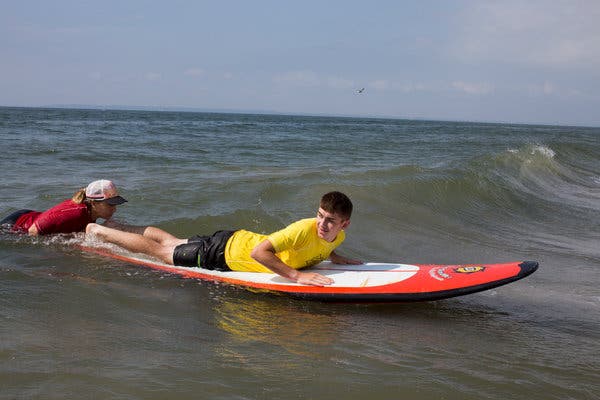Dylan Hronec has been in a wheelchair since he was 2 years old.
Surfing is his favorite activity.
“When you’re surfing you don’t really think about anything else — it’s the closest thing to an out of body experience,” said Mr. Hronec, 27, who has cerebral palsy and uses a special surf board retrofitted with handles to help him grab on. “I’m more in control of my body and my muscles in the water. So I’m not limited in any way.”
Surfing is one of the newest sports to make it into the 2020 Olympics in Japan, and it’s something more and more people with disabilities, both physical and cognitive, are taking part in. More than 30 countries have adaptive surf programs, geared to those with disabilities; the International Surfing Association has petitioned the International Paralympic Committee to add adaptive surfing to the Paris games in 2024.
To that end, several nonprofit groups cater to surfers with disabilities, including autism, visual impairments and limb loss. They include the Challenged Athletes Foundation, Life Rolls On and the Association of Amputee Surfers, or AmpSurf, which has chapters in New England, New York and California and holds free surfing clinics all year long.
“Surfing is a lot different than a typical activity people might get involved in, like basketball, tennis or volleyball,” said John W. Roberts, 71, a retired health and physical educator in Rockaway Beach who has been surfing for 55 years and is the coordinator of the New York chapter of AmpSurf, which has a focus on veterans. About 500 people a year participate in various AmpSurf events; participants, including both veterans and non-veterans, are given instruction on land and then teamed up with a mentor to help them in the water.

“The environment is always changing,” he said. “Surfers are attracted to that. It’s very physical and very spiritual.”
Ryan Fitzpatrick would agree with that. Mr. Fitzpatrick, 14, was born without a right leg above his knee. His mother, Deirdre, heard about The Limb Kind Foundation, founded earlier this year by New York prosthetist Robert Schulman. In July, she brought her son to an event in Long Beach.
“My instructor told me to put my knee up to the board and slowly get up and balance,” said Mr. Fitzpatrick, a high school freshman from Sherman, Conn. “I was able to get up there for a few seconds. I was really surprised I could do it. It was really cool with the waves coming behind you — seeing all the people cheering and clapping.”
For Jase Wheeler, 47, a Gulf War veteran whose legs were amputated above his knee after a botched military training exercise, surfing is like “playing a song.” In July, Mr. Wheeler, of Dallas, visited Rockaway Beach for an AmpSurf event. “You feel the electricity of the water and it speaks to you.” His German shepherd, Justice, got up on the board with him.
Of course, “getting up on the board” means different things to different people. Some stand, some kneel, some lay on their bellies. How they ride their board is beside the point.
“The best two waves I caught, I was lying down,” said Dana Cummings, 49, a Marine who lost his leg below the knee in a car accident in 2002. Four months later, he learned to surf. He co-founded AmpSurf in Pismo Beach, CA in 2003. “It doesn’t matter how you do it. If you’re riding a wave, you’re surfing.”
It’s also therapeutic. Mr. Cummings, who is a member of the U.S. Surf Team and will compete in the ISA World Adaptive Championships, suffers from post-traumatic stress disorder. Surfing calms him down. “You’ve got to focus on what you’re doing,” he said.
For people with cognitive disabilities, surfing offers sensory pleasures. That was one of the main reasons Marcie Santiago brought her son, Bryce, who has autism, A.D.H.D. and limited language function to a weeklong surfing camp in Long Beach with Surf For All.
“Bryce loves water in any capacity — baths, pools, sprinklers, swim class,” said his mother, a special education teacher. “The fact that it involved water made it easy for him to go with the instructor. He even liked the rocking of the waves and the taste of the salt water. So many pieces of it meet his sensory needs.
“He went out with his instructor and he was in heaven,” she continued. “He was sitting up on the board, he looked so excited. When he came to the shore he had a big smile on his face. Everyone was cheering and clapping. He said, “I want more yays!” She plans to buy him a wetsuit so he can surf through the fall.
Mr. Hronec has competed in the U.S. Adaptive championships in the adaptive division and spent time at surfing champion Kelly Slater’s Surf Ranch, in Leemore, Calif., where he rode an artificial wave nearly six feet high. Nothing scares him.
“It’s pretty insane — I’ll go out in hurricanes and heavy swells,” he said. “My safety team will drag me out into the water, and people will be like, what are they trying to do to this kid? Are they trying to kill him?
“It’s a hot moment when they realize that even though I may be limited on land, I can surf just the same as everybody else,” he said. “I’m in the exact same condition as everyone else.”

